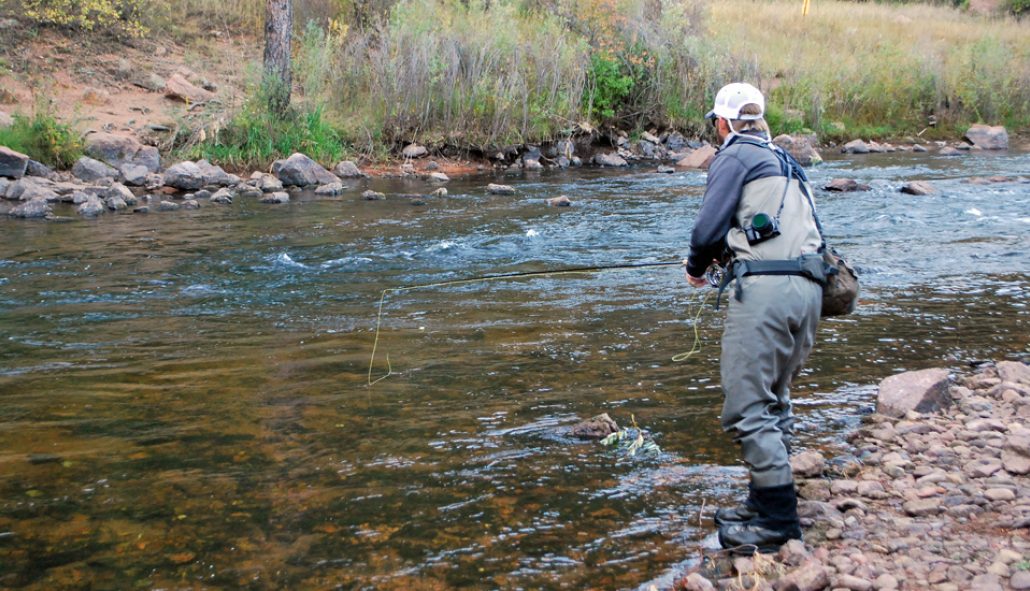Sight fishing for trout can be one of the most rewarding ways to put a fish in the net. The thrill of the stalk and cast, watching them eat, and of course the 'is he going to stay there long enough for me to get this cast off?!' adrenaline rush is something that still gets me unbelievable excited each and everytime I hit the water. And while the topic of sight fishing is something that could go on at length, here are three quick tips to put to use next time you hit the water.
1. Make Sure Your Flies Land Upstream Of Your Indicator- Given the amount of time I spend on the South Platte (however this still applies on any river where sight fishing is applicable) I spend a lot of time -whether guiding or personal fishing- sight fishing. This first tip is a very important one and is something I particularly work on a lot with customers. When sight fishing to a trout, your goal is to always get your indicator to "stripe it's back". i.e.- make your indicator run right down the length of the fish, right over the top of it. This is important because it ensures your flies are maximizing their chances at entering the fish's feeding zone. I've been known to say on contless guide trips, "We want to present our flies so perfectly that they either have to eat them or get out of the way!" Many times I'll have a customer make a great cast where the indicator goes right over the top of the fish (stripes it's back), only to come up fishless. The reason for this is that their flies are usually not inline with their indcator, but rather outside of the indicator. It takes a little bit of work, but next time you're out on the water practice making some presentations (pick an imaginary target, rock, etc) and take note of where your indicator is landing in relationship to your indicator. Experiment with the angle/path your rod is traveling on when making the cast. Oftentimes it only takes a quick adjustment (usually bringing the rod up a little higher and 'over the top') to get your flies landing directly upstream of your indicator every single cast. side note: the position of your body vs. the target can make this much easier to accomplish. The greater the angle you have to your target, the easier it will be to get your flies to land direcly upstream of your indicator. Standing directly across from your target will be the toughest angle. I recommend taking at least a 45 degree angle to your target.
2. Recast As Soon As Your Flies Pass The Fish- One thing that always remains constant when sight fishing is that we never know how long a fish is going to stay put and allow us to keep casting at it. When sight-fishing to a fish, your goal should always be to re-cast as soon as you know your flies are passed the fish. The way to tell your flies have passed the fish is simple and it all comes down to the distance between your indicator and bottom fly. If I'm spread out 6 feet from indicator to bottom fly, then as soon as my indicator is 9 or 10 feet passed the fish I will re-cast. I know this sounds simple but I've seen far too many times where the fish may be 25 or 30 feet away and my customer wants to let the indicator drift all the way back to us before recasting. Going back to the "6 feet" example from a couple sentences back, I recommended 9 or 10 feet as my mark to re-cast just to give a little extra padding that my flies are well past the fish and I don't run the risk of foul hooking it on the tail. Our goal is to get our flies to make as many drifts by the fish as possible. Waiting for our indicator to float all the way back to us will never be the best way to make this happen.
3. Never Make A Cast Standing In The Water That You Could Make Standing On The Bank- I saved this point for last for a reason. It is that important. When fishing a pressured tailwater it is absolutely unbelievable how much closer you can get to the fish by keeping your feet on dry ground. Walking through the water will send vibrations and noise firing through the water that will be instantly picked up by a trout's lateral line. I typically find that the shallower the fish is holding, the more sensitive they are to this. If you've never paid attention to this before, focus on where you're casting from throughout the day and determine whether or not that cast could have been made from dry ground. Start making as many of these casts as possible with a little terra firma under your vibram soles and I'm confident you'll start needing that landing net a little more.
As always, if you'd like to disucss the topic above- or any other for that matter- feel free to reach out to me directly. Got an idea for something you'd like to see discussed on the Blog? I'm always happy to take any/all feedback or advice. kyle@troutsflyfishing.com
Thanks again for keeping an eye on the Blog and good luck out there everyone!

